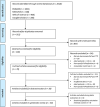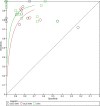Discriminators of pseudoprogression and true progression in high-grade gliomas: A systematic review and meta-analysis
- PMID: 35918373
- PMCID: PMC9345984
- DOI: 10.1038/s41598-022-16726-x
Discriminators of pseudoprogression and true progression in high-grade gliomas: A systematic review and meta-analysis
Abstract
High-grade gliomas remain the most common primary brain tumour with limited treatments options and early recurrence rates following adjuvant treatments. However, differentiating true tumour progression (TTP) from treatment-related effects or pseudoprogression (PsP), may critically influence subsequent management options. Structural MRI is routinely employed to evaluate treatment responses, but misdiagnosis of TTP or PsP may lead to continuation of ineffective or premature cessation of effective treatments, respectively. A systematic review and meta-analysis were conducted in accordance with the Preferred Reporting Items for Systematic Reviews and Meta-analyses method. Embase, MEDLINE, Web of Science and Google Scholar were searched for methods applied to differentiate PsP and TTP, and studies were selected using pre-specified eligibility criteria. The sensitivity and specificity of included studies were summarised. Three of the identified methods were compared in a separate subgroup meta-analysis. Thirty studies assessing seven distinct neuroimaging methods in 1372 patients were included in the systematic review. The highest performing methods in the subgroup analysis were DWI (AUC = 0.93 [0.91-0.95]) and DSC-MRI (AUC = 0.93 [0.90-0.95]), compared to DCE-MRI (AUC = 0.90 [0.87-0.93]). 18F-fluoroethyltyrosine PET (18F-FET PET) and amide proton transfer-weighted MRI (APTw-MRI) also showed high diagnostic accuracy, but results were based on few low-powered studies. Both DWI and DSC-MRI performed with high sensitivity and specificity for differentiating PsP from TTP. Considering the technical parameters and feasibility of each identified method, the authors suggested that, at present, DSC-MRI technique holds the most clinical potential.
© 2022. The Author(s).
Conflict of interest statement
The authors declare no competing interests.
Figures




References
Publication types
MeSH terms
LinkOut - more resources
Full Text Sources
Medical
Miscellaneous

